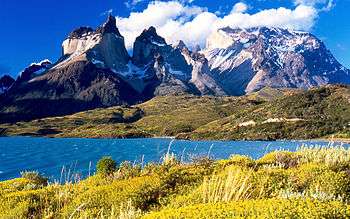Pampia
| Geology of the Andes |
|---|
 |
| Orogenies |
| Pampean orogeny |
| Famatinian orogeny |
| Gondwanide orogeny |
| Andean orogeny |
| Fold-thrust belts |
|
Central Andean | Patagonian |
| Batholiths |
| Peruvian Coastal | North Patagonian | South Patagonian |
| Subducted structures |
|
Antarctic Plate | Carnegie Ridge | Chile Rise | Farallon Plate (formerly) | Juan Fernández Ridge | Nazca Plate | Nazca Ridge |
| Faults |
| Andean Volcanic Belt |
|
Northern Zone| Peruvian flat-slab | Central Zone | Pampean flat-slab | Southern Zone | Patagonian Gap | Austral Zone |
| Paleogeographic terminology |
|
Arequipa-Antofalla | Chilenia | Chiloé Block | Cuyania | Iapetus Ocean | Madre de Dios Terrane | Mejillonia | Pampia |
Pampia was an ancient microcontinent or terrane that collided with Río de la Plata Craton and Río Apas Craton during the Pampean orogeny of late Proterozoic and early Cambrian.[1] It was one of the first terranes to be amalgamated to the old cratons of the east, and was followed by the suturing of Cuyania and Chilenia terranes into the young South American Plate.
Sources
References
- ↑ Gaucher, Claudio; Bossi, Jorge; Blanco, Gonzalo (2010). "Paleogeography". In Gaucher, Claudio; Sial, Alcides; Haverson, Galen. Neoproterozoic-cambrian tectonics, global change and evolution: a focus on south western Gondwana. Elsevier. p. 137.
This article is issued from Wikipedia - version of the 1/7/2016. The text is available under the Creative Commons Attribution/Share Alike but additional terms may apply for the media files.